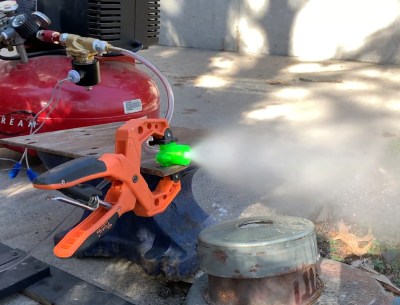Conceptually speaking, a liquid propellant rocket engine is actually a very simple piece of hardware. All you need to do is spray your fuel and oxidizer into the combustion chamber at the proper ratio, add a spark, and with a carefully designed nozzle you’re off to the races. Or the Moon, as the case may be. It’s just that doing it in the real-world and keeping the whole thing from exploding for long enough to do some useful work is another story entirely.
Taking the process one step at a time, [Luke Walters] has been working on a 3D printed injector that tackles the first half of the problem. After nearly a dozen different prototypes, he’s come up with a printable injector design that atomizes the fuel and combines it with pressurized air at a suitable ratio for combustion. As you can see in the video at the break, it’s certainly capable of generating some impressive fireballs.

The internal passages of the injector have been designed in such a way that fuel (91% isopropyl alcohol) and air are spinning in opposite directions when they meet. This promotes more complete mixing, which in turn leads to a more efficient burn. Originally developed in the 1930s, so-called “swirl injectors” of this type were one of the key technological advancements made by Germany’s V-2 rocket program. Some ideas never go out of style.
Since the injector only touches the fuel and air prior to ignition, it doesn’t need to be particularly heat resistant. To be on the safe side [Luke] has printed the part in PETG at 100% infill, but in reality the flame front is far enough away that temperature isn’t much of a concern. That said, he does hope to eventually fit these injectors into some kind of combustion chamber, which is where things will start getting toasty.
To be clear this is not a rocket engine, and it produces no appreciable thrust. Turning a big flame into a useful means of propulsion is where things get tricky, almost as though it’s rocket science or something. But that doesn’t mean it can’t be done by suitably ambitious hackers.















So potentially useful in current pandemic for just hosing down everything with unlit isopropyl alcohol too :-D
what could go wrong, right?
You could still light it, if the threat increases or zombies attack. :-)
Not a rocket guy. The orange flame means there are a lot of carbon particles i.e. fuel mix too rich incomplete combustion. You want the mixture as close to explosive mixture ratio as possible.
The power went out a few days ago. I made a penny stove that burns isopropyl alcohol. I had a little accident spilling some alcohol around the stove. So when I lit it, the spilled alcohol lit up and overheated the outside stove. There was some very impressive jets coming out of it. Even then, the flames remains blue with a tiny bit of orange at the tips. That bought the water in the pot boiling very quickly. After the stove cools down, it was burning normally and there was no incident. :)
He could have been running fuel rich to show off for the camera. In any event though, the ratio should be easy enough to adjust with a regulator on the fuel line.
Rocket engines are usually run fuel-rich. While it yields less combustion energy per unit fuel, the energy per unit propellant mass (fuel + oxidizer) doesn’t suffer much at first. It significantly reduces the flame temperature, which makes it easier to build a combustion chamber and nozzle that won’t melt, and the drop in average molecular weight of the exhaust makes up for some of the energy drop.
Also if you’re running in atmosphere you might worry about producing nitrogen oxides, which being an endothermic reaction sucks energy out of the burn so may end up less efficient vs making sure you run cool enough not to make them.
Well, if you’re running it with air as oxidizer, anyways. If you’re running a better oxidizer through the thing then it’s not exposed to nitrogen for that reaction to happen until it meets ambient air after (hopefully) at the edge of the nozzle, and by that point you don’t care.
Scott Manley just published a GREAT video about rocket fuel injectors:
https://www.youtube.com/watch?v=aa4ATJGRqA0
– Nice, thanks!
Sure thing :)
Unfortunately, there is no thrust there.. unless you count the reaction from the compressed air. All the combustion is happening outside of a non-existent combustion chamber. There can be no thrust when this happens as the reaction is (mostly) equally exerted in all directions. The only “thrust” you’s see here from the perspective of the “engine”, would be the apparent thrust from the shockwave of the external chemical reaction ( which isn’t thrust). Sorry.
Nobody said there was any thrust. In fact, the post specifically says there isn’t. Did you actually read it before leaving this comment?
Nah, off course he didn’t. Isn’t this how the internet is supposed to work? You post something, someone don’t read, complain about something you didn’t said, and you both start a flame war?